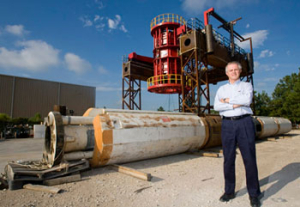Days before residents on the Gulf coast were evacuated for Hurricane Ike, aircrafts were ferrying crews in the area from the offshore rigs and platforms responsible for a quarter of U.S. oil and 15 percent of natural gas production.
In the storm's aftermath, some 111 of the 694 manned platforms in the Gulf remained evacuated Monday as production numbers remain below average for the second week following Ike's landfall, said Caryl Fagot, spokesperson for the U.S. Minerals Management Service.
With each day, hundreds of thousands of dollars are lost as the industry works to return to pre-Ike production.
“As of today, 48 percent of oil and 47.4 percent of natural gas is shut-in,” said Fagot, whose agency monitors energy companies operating in the Gulf, of Monday’s report on Gulf production. “For whatever reason, the gas and oil normally produced is not being transported to shore to be refined because of possible pipe line or rig damage as a result of Ike.”
A new technology being created by Benton Baugh (1967 BSME), an adjunct professor in the University of Houston’s Department of Mechanical Engineering, is expected to tip the scales to some of these losses by helping protect one of the Gulf’s largest producers from perils next hurricane season.
Beginning this fall, Baugh’s drilling riser centralizer system will find its way 150-miles southeast of New Orleans to BP America’s Thunder Horse, the largest moored semi-submersible oil platform in the world. The system, designed by Houston-based Radoil, Inc. where Baugh is president, could not only reduce risk to the riser and rig, but significantly cut the number of down production days by allowing subsea drilling equipment added security in the stronger currents produced by looming hurricanes.
“If the wrong currents are in the Gulf of Mexico it will push the riser against the side of the rig floor and you can’t pull it up,” Baugh said, noting in this scenario the riser can be bent and other damage can be incurred by the rig. “The riser generally has to be pulled up in currents of about a knot. With this in play, they will be able to pull the riser up in currents of two and a half knots and get to safety immediately.”
It was these stronger currents during Ike, the mineral management service has reported, damaged risers or flex joints on multiple platforms in the Gulf. Repairs, Fagot indicated, could take up to three months. Baugh’s technology is expected to reduce the risk of such damage to the Thunder Horse, which at its peak is expected to produce near 250,000 barrels a day.
The quarter of a million pound cylindrical system stands near the height of a one-story building. When activated, it utilizes 64 internal rollers that have the ability to clamp around the drilling riser, stabilizing it for higher currents as its pulled from the ocean bottom more than 6,000 feet below the rig.
The multi-million dollar system, Baugh said, reduces the possibility of damage to the riser, increasing the outcome it will be pulled to safety without adverse consequences. The extra security, he said, could ease some of the production troubles faced after Ike if the Gulf faces another active hurricane season next year.
